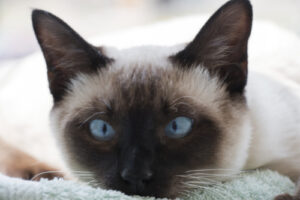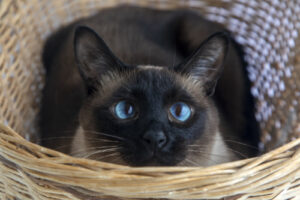Introduction
Did you ever see cross eyed cats? Their eyes and pupils are pointing in different directions. In veterinary medicine, we call this strabismus. It occurs when the muscles that control eye movement do not work properly. This causes one eye to point in a different direction than the other eye.
Crossed eyes are seen in both humans and animals, including cats. Although it may look unusual or cute, it sometimes causes slight problems in cats. But in most cases, they don’t notice it at all.

Symptoms in cross eyed cats
As already mentioned, cross eyed cats have one eye that points in a different direction than the other eye. This can be a permanent position of the eyes. But it can also come and go, depending on the underlying cause. Especially at the end of their active period (many cats live mainly at night and sleep during the day), when they are a bit tired, their eyes will cross more than when they have rested.
In addition to the crooked eye position, cross eyed cats also sometimes have problems with depth perception. While most cats can easily jump onto a small object (such as a mouse or bird), cross eyed cats often have difficulty with this. Since they live in our homes and get food in their bowl without having to do anything for it, it is usually not a problem. But a cat that has to hunt for its own food by catching birds or mice may have to make some extra effort.
In cross-eyed cats, no discharge is seen. Also an abnormal cornea is not to be noticed. And the condition isn’t painfull for the cat.
Causes of cross eyed cats:
The crooked eye position can have many causes. For example:
- Hereditary conditions – Crossed eyes occur more frequently in some breeds than in other breeds. For example, Persian cats and Siamese cats have relatively many cross eyed cats in their population.
- Injury or trauma – A blow to the head or injury to the eye can cause cross-eyedness in cats. This can happen because the eye muscles are damaged or the brain cannot control the eye muscles properly.
- Neurological problems – Disorders of the nervous system can affect the muscles that control eye movement.

Diagnosis and Treatment:
You can diagnose it yourself quite easily. You can hardly miss it. If the cat has been cross-eyed since birth, there is no reason to visit a veterinarian. However, keep in mind that it may have difficulty estimating certain heights and may fall easily. It may be wise to place extra surfaces halfway along a certain route so that it can move around more safely in a cat paradise.
If your cat was not cross-eyed before, but suddenly comes home cross-eyed, it is wise to take it to a veterinarian and have it checked. It is possible that it was hit by a car, for example. The cross-eyedness itself is harmless, but there may be more physical damage as a result of the accident. In cases of sudden cross-eyedness, the veterinarian often chooses to administer very strong anti-inflammatory drugs to reduce swelling in the brain and nerve pathways. The eyes will then quickly assume a normal position again and the brain can start to recover.
Operation for cross eyed cats
In humans, eyes are often surgically straightened if it is a congenital problem. This surgery is also possible in cats, but it is rarely done. Cross eyed cats are not bullied at school and are also not likely to want to watch a 3D movie. They are not aware of the fact that they see depth slightly less than other cats. And since we can help them with food, an operation is not necessary.

Breeding with cross eyed cats
If you breed with cats, it is wise to think carefully whether you want to breed with cross eyed cats. It is hereditary and therefore the kittens can be carriers of genes that cause cross-eyedness. Make sure that the kittens are not simply bred into litters when they are old enough. Decent knowledge of proper breeding policy is required for this.
